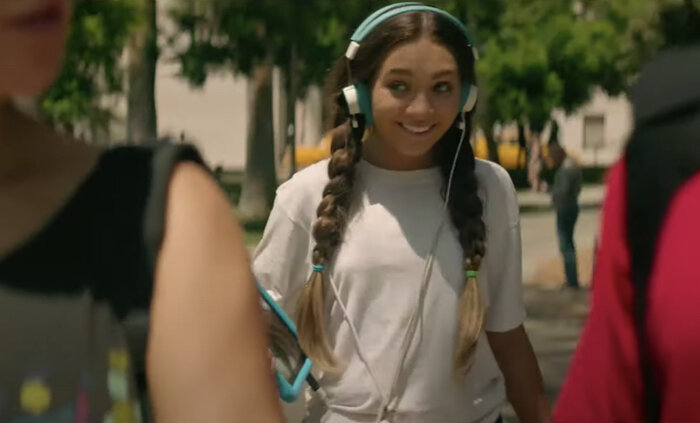By Jill Escher
A short while ago I published a piece decrying the Twitter-mob hysteria around Music, a new film by the Australian musical artist Sia, and in particular the vitriolic attacks on her for doing something that is utterly and completely within the bounds of reasonable artistic endeavor — casting a non-disabled actor as a character with a severe form of autism.
My piece was limited to the toxic fanaticism about the casting issue, and not the merits of the film, which was not yet available in the U.S. Now I’ve had a chance to see the film, I thought I’d share some thoughts.
It is hardly an instant classic. The script felt somewhat like a first draft. The characters were fairly one-dimensional and cliche. The musical fantasy numbers, featuring big puffy candy-colored costumes and music that sounded bland to my ears, failed to add much substance to the thin plot. While Sia surely deserves chutzpah points for striving to create a heart-touching musical based on gritty modern themes, and for deploying her multidimensional talents including writing, directing, music composition, and performing, overall I found it a forgettable film.
But the movie did have its high points, and one was the character of Music, as played by Maddie Ziegler. I realize some in the autism community profess to be offended by the portrayal, but why? Perhaps it wasn’t perfect, but it was a beautiful performance on many levels.
The one thing that keeps you watching the film when you could just as easily shut your laptop and walk away is that from the very first scene you care about Music. As she starts her day with her daily eggs prepared by her doting grandmother, you immediately see her vulnerability, joy, turmoil, anxiety, humanity, and irrepressible inner light. You see she is severely disabled, yes, but throughout the film, this portrayal is delivered with a loving empathy and without an ounce of mockery or condescension. A reviewer called it “cartoonish” but I cannot agree — Ziegler delivered a fleshed-out performance with plenty of nuance.
Indeed, it struck me that Ziegler must have done considerable research for this role. In Music’s physical and behavioral traits I recognized abundant real-life characteristics I see among my real-life autistic friends. The overbite may seem corny to some, but it looked almost exactly like the profile of a few autistic girls I know. The toe-walking is of course a reality for many with severe autism. The gentle head sway seemed straight off the shoulders of my autistic friend Jacob. The giant goofy grin reminded me of several severely affected young women I know, including my own nonverbal autistic daughter, Sophie. The meltdowns, the hypersensitivity to sound, the calming response to music, the obsession with a little-kids’ TV show, all very real, and well played, and all the more impressive considering this actor is so young and comes from a background as a dancer, not a thespian.
The pieces that struck me as most unrealistic are attributable to the script, and not to Ziegler’s attempts to embody a teen with this level of disability. For example, it’s rather unlikely that an autistic girl at her level of functioning would take walks every day by herself in her neighborhood, or even brush her teeth by herself. And given this is supposed to be contemporary downtown Los Angeles, where were the school and regional center services and supports for which Music most assuredly would have been eligible? (Call me literal, sorry.)
Furthermore, Ziegler plays not just one but two roles in the film. In the reality parts she’s that teen with severe autism who falls under the care of her much older half sister, Zu, played by Kate Hudson. In the musical fantasy parts she dances expressively while wearing costumes so over-the-top they make Mark Morris look sedate by comparison. A tall order for any actor.
There is also a hullaballoo about the scenes in which Music is restrained, with some advocates calling the film dangerous for portraying unsafe techniques. I saw these scenes as a big ol’ “meh" that certainly would not communicate life-endangering information to any reasonable person. There was no prone restraint, at least in the sense that I know the word. Yes, adults sit atop her and pin her arms for brief periods in two scenes, but so what? These things happen all the time in the real world and the real homes with severe autism to address immediate safety concerns, whether we like it or not. More importantly, I hope it goes without saying that no one would mistake this film for an instructional video for autism practitioners; and certainly there’s no sense that Sia is attempting to excuse or endorse any harm or violence to people with disabilities. Finally, compared to the prodigious amount of deadly brute force featured in movies on a regular basis (have you watched Gladiator lately?), the minor physical altercations seen in Music barely score a tiny blip.
It’s also worth noting another positive for this film — it is probably among the first feature films to touch on a huge and growing social issue of what happens when autism caregivers die. Let us hope that more and more filmmakers have the courage to shine a light on this urgent issue without fear of online reprisal from neurodiversity activists intolerant of imagery around severe autism.
In the end, if you’re interested in seeing a fictional character with a severe form of autism portrayed with a great deal of love and verve, watch this film. But if you’re looking for a peak cinematic experience, take a pass.
Jill Escher is President of the National Council on Severe Autism.
Disclaimer: Blogposts on the NCSA blog represent the opinions of the individual authors and not necessarily the views or positions of the NCSA or its board of directors.

